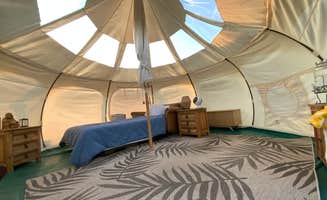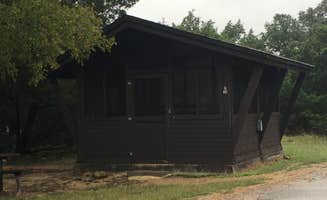Glamping accommodations near Cameron, Texas offer diverse options for overnight stays with electricity, shade structures, and water access. Sites range from basic electric/water hookups to more developed glamping spots with covered pavilions. Most campgrounds maintain minimal facilities with vault toilets, while a few provide shower access and dump stations for recreational vehicles.
What to Do
Fishing opportunities: Wilson H Fox Park provides access to crappie fishing along Lake Granger. "You wonder what this lake is best for fishing? It's crappie," notes Douglas D. about Wilson H Fox. The lake features fishing piers and shoreline access from multiple campsites.
Hiking trails: Lake Bryan offers approximately 20 miles of marked trails through wooded areas near the water. "The hiking trails at Dana's Peak provide beautiful scenery along the trails," mentions Janese W. about Dana Peak, which features multiple trail systems connecting throughout the park.
Swimming areas: Designated beach areas at several campgrounds provide sandy entry points for water access during warmer months. "We had a quaint campsite with a Lakeview. There was a fishing pier, boat ramp, and beach to swim at," reports GoWhereYouAreDraw N. The swimming areas typically don't have lifeguards, so visitors should practice water safety precautions.
What Campers Like
Covered picnic areas: Many campsites include permanent pavilion structures that provide shade during hot Texas days. "Each space had a picnic table and grill. The coverings over the tables are thick wood and very large on a concrete pad," Amy H. shares about Cedar Breaks Park, where most sites include these structures.
Distance between sites: Campers frequently note the spaciousness and privacy between campsites. "The sites were spaced out so that you're not camping on top of one another. Each space had a picnic table and grill," mentions GoWhereYouAreDraw N. Some loops offer more privacy than others, with outer loop sites typically providing more separation.
Wildlife viewing: The natural surroundings support various wildlife, particularly at dawn and dusk. "We come here every year. Quiet, calm. Fishing, swimming, animal watching, it has it all," explains Elizabeth M. Deer sightings are common throughout the camping areas, especially in less developed sections.
What You Should Know
Limited shade options: Several camping areas lack significant tree cover, creating challenges during summer months. "Not many actual camp sites and every site is sunny," warns Deb about Dana Peak. This affects comfort during peak summer temperatures from June through September.
Bathroom facilities vary: Restroom accessibility and cleanliness fluctuate across locations. "Bathrooms seem iffy. One had intermittent water issues, not flushing. Automatic timed lights can be a pain. Especially if natural light is limited," explains Joseph C. about Wilson H Fox.
Seasonal flooding concerns: Some areas experience periodic flooding that impacts trail conditions and access. "Sommerville has been wrought with flooding and hogs...both running a 'could be' beautiful landscape. Many of the rails were unusable," reports Kevin M. Weather forecasts should be monitored before planning trips, particularly in spring.
Tips for Camping with Families
Playground availability: Several campgrounds maintain playground equipment for children. "We road bicycles, played on the playground. Hiked around and fished," shares Cathy C. about Cedar Ridge. The playgrounds typically feature basic equipment without specialized features for very young children.
Swimming safety: Designated swimming areas provide safer experiences for families with children. "The swimming area was great. They were not doing a good job of keeping the bathrooms clean. This was really our only complaint," notes Bobby A. Parents should bring water shoes as some swimming areas have rocky or uneven shorelines.
Site selection for shade: Campsite locations with adequate shade become crucial for family comfort. "If you study the park map it is very easy to find a spot with lots of shade. Spots are spacious, some large," advises Roscoe's R. Sites with east-facing orientations provide morning shade while west-facing sites offer afternoon relief.
Tips from RVers
Site leveling challenges: RV campers note significant leveling issues at certain locations. "The sites along the inside are scary unlevel! Some of the big rigs were backed in and jacked up 4 feet or so in front. Saw a lady break her ankle stepping out of her camper," warns Karen H. about Lake Somerville State Park Birch Creek Unit. Bringing additional leveling blocks proves essential.
Limited hookup availability: Many sites offer only water and electric connections without sewer. "30/50 amps, and water hook ups. No sewer," reports Mary S. Dump stations serve as the alternative, requiring strategic tank management for longer stays or planning to relocate RVs to dump stations periodically.
Accessibility considerations: Some campgrounds have restricted access for larger RVs. "We stayed in spot 58 which is on a small bluff overlooking the lake. We had a trail from our spot to the lake which we took advantage of," mentions Mark S. Researching specific site dimensions before booking prevents arrival complications for larger rigs.



